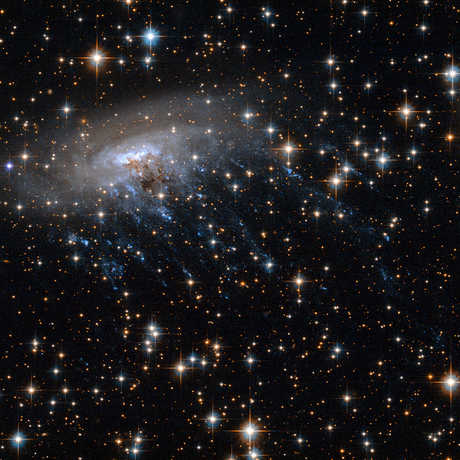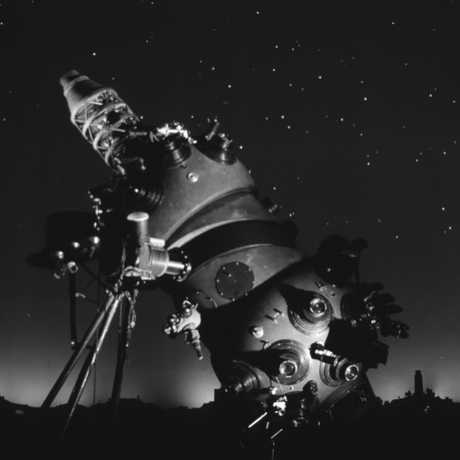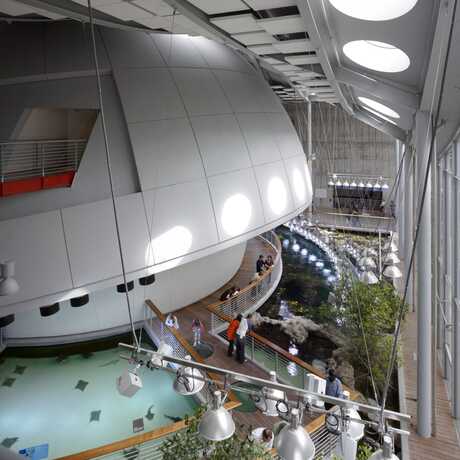Each month, renowned astronomers share their latest research at Morrison Planetarium.
Universe Update
Theater of the Stars

Do you remember the original Morrison Planetarium? Recently, we celebrated its 67th birthday; it opened on November 8, 1952. I joined the Planetarium staff in 1973, and have many fond memories of the original “Theater of the Stars.” I shared some reminiscences at NightLife recently, and thought I’d share them here, too.
The original Morrison was a little different from the dome we have now—at 19.8 meters (65 feet) in diameter, it was just a bit smaller across than the present 23-meter (75-foot) dome. It also wasn’t tilted, and all the seats faced the star projector at the center of the theater, giving a sense of sitting around a campfire on a starry night.
Original Planetariums

Optical projection planetariums were invented in the 1920s by Carl Zeiss AG in Jena, Germany. They were the first virtual theaters where audiences could be convinced that they were somewhere else—outside, looking up at a clear night sky, which was projected inside a dome. That’s what planetariums did best, and the first presentations were mostly about what could be found in the night sky and how to understand how the sky moves and changes.
The first planetarium in the U.S. was the Adler Planetarium in Chicago, which opened in 1930. Not long after that, in 1932, there was interest in building a planetarium in San Francisco, but the idea stalled until after World War II. By that time, there were six big planetariums in the U.S., all with German-built Zeiss star projectors.
Morrisons Early History

Morrison Planetarium was the first American-made planetarium star projector for a large dome. There were other projectors built in the U.S. as early as the 1930s, but they were made for smaller domes, and in planetariums, size matters: the larger the dome, the more realistic the projected sky looks because from the way your eyes focus, you instinctively have a rough idea of how far away something is. Research has shown that the illusion of looking at distant stars in the sky is more convincing in domes larger than 50 feet across, so that size is typically used as the lower cutoff to define a “major” planetarium (although that doesn’t make the smaller domes any less important).
Morrison's sky shows were operated manually by a live lecturer who turned things on and off while speaking, so the job was often compared to being a DJ. They usually began with a gradual sunset in the west with some nice music, and ended with an uplifting sunrise in the east and a cheery "Good Morning!" (No matter what the real time was.) While an automation system was proudly touted at the Planetarium's opening, it was abandoned because it was great at turning things on, but not so good at turning them off. We decided the technology needed to mature, and didn't consider a more reliable system until the late 1980s.
The several-minutes long transition to darkness gave audiences a chance to gracefully adapt to the darkness of the night sky, and it heightened visitors’ anticipation as they waited for the first stars, watching them gradually appear, one by one. After the stars appeared, the first thing many people saw was the lecturer’s arrow, a special projector that he (or she) used to point to various objects of interest.
For a short time, the Academy marketed a series of “planetarium-style” lectures that were recorded on the medium of the day: vinyl phonograph records. This series featured planetarium topics such as the Moon, Mars, or the search for life. They were narrated by Hubert J. Bernhard, one of Morrison Planetarium’s lecturers, presumably providing a “voice of authority,” complete with dramatic-but-cheesy background music played on a Hammond organ. They were sort of the equivalent of the current monthly Benjamin Dean Lectures, which really do feature voices of authority in the form of astronomers and NASA scientists giving talks to the public about their work. Five LPs were produced, and seeing how astronomical knowledge and production sensibilities have changed over time, they’re charmingly-outdated. A recording about one of the more sensational and popular topics of the day—UFOs—can be found here.
At the time, Morrison Planetarium also used projected panoramas of artwork to enhance the illusion of being outside or somewhere else on Earth, or somewhere else in the Solar System. Some very talented artists—including David Porazzo, Donald Davis, and Lynette Cook—created panels representing the surface of the Moon or Mars, ancient Egypt, or Stonehenge, or some other scenario. These came from a set of evenly-spaced slide projectors along the dome, blended together at the edges to form a continuous, 360° landscape along the horizon (or just a part of one, depending on what was needed).
At the time, producing animated effects was more of a challenge, and this is where people got really imaginative, shining light through rippled plastic or textured glass to get the effect of a nebula, an aurora, or a comet—and it was amazing what you could do with crinkled aluminum foil, weird-looking bottles, light bulbs inside rotating soup cans, or baby-food jars with patterns painted on them. And enough watts of light.
Vortex and Laserium

It wasn’t long before more creative minds wanted to take fuller advantage of the planetarium environment, and in 1957, the world’s first psychedelic planetarium light show was presented at Morrison Planetarium. These were the Vortex concerts, and the name may sound familiar if you’re a NightLife regular, because we occasionally present Vortex 2.0, which is a modern homage to the original, using our digital fulldome system, featuring animations from various computer graphics artists.
The original Vortex featured electronic music—which in the ’50s didn’t sound like what we might call electronic music today (if you’re a fan of science fiction movies, think of the soundtrack to Forbidden Planet). Thanks to the then-new medium of magnetic tape, there was a lot of playing around with sound effects such as reverb and loops.
Sound artist Henry Jacobs recognized that the original planetarium had speakers distributed along the dome, surrounding the audience, and he used a hand-crank that could direct pre-recorded audio to any speaker he wanted. With it, he could make the sound circle dizzyingly around the audience, creating a “vortex” of sound (hence the name).
Accompanying Jacobs’s soundscapes were abstract visuals created by filmmaker Jordan Belson, operating up to 30 different slide projectors, kaleidoscopes, strobes, zooms, and Moiré pattern projectors, producing a sound-and-light environment unlike anything seen before—and the forerunner of all trippy light shows and music visualization experiences that followed and which continue today.
Vortex was presented in five short runs through 1959, and even went outside the U.S. to Belgium and Canada. Ultimately, though, while audiences and critics liked it, the museum administration decided that Vortex attracted the “wrong kind of crowd”—beatniks and other people who were more interested in art than in science.
Vortex was briefly revived one more time in 1974, and was followed by the Northern California premiere of Laserium. It premiered in Los Angeles in 1973, then came to San Francisco the following year, running from 1974–1979 and 1983–2000, becoming a worldwide phenomenon that played in dozens of planetariums around the world and had many imitators. The name “Laserium” became the “Kleenex” or “Band-Aids” of the laser show industry, used by many as a generic term for any laser show.
Unlike the response to Vortex, the fact that Laserium attracted audiences that might not ordinarily visit science museums was eventually seen as a good thing, and in its heyday, Laserium was so popular that many people thought it was the only program Morrison Planetarium delivered. And what it did was to bring music visualizations to millions of visitors, with content ranging from classical to rock to jazz and new age and shows highlighting the music of Pink Floyd, Led Zeppelin, the Doors, the Beatles, the Police, and others—all under Morrison Planetarium’s starry sky, which provided the proper amount of “spaciness.” We’re often asked if we’re ever going to do laser shows again, but things aren’t as simple as they used to be, and doing so would be much more difficult, given the tilted configuration of the planetarium today.
The San Francisco Skyline

One of many visitors’ favorite features of the original planetarium was the San Francisco skyline that was cut out of the sheetmetal of the dome itself. It featured the silhouettes of recognizable landmarks such as SF City Hall, the Golden Gate and Bay Bridges, Coit Tower, Alcatraz, Mount Sutro and other hills of San Francisco, the De Young Museum, and even the Farallon Islands. The fact that the skyline was a permanent feature meant that it could never be hidden from view, so when projected panoramas were used to represent Mars or the Moon, it wasn't unusual to see City Hall or Coit Tower sticking up out of a crater.
Interestingly, the San Francisco skyline was featured in an imaginary planetarium visited by children’s clay animation character Gumby in an episode called “Space Oddity” broadcast in 1988. In the story, the planetarium looked a lot like an observatory on the outside, and the star projector inside looked more like a German Zeiss, but up along the horizon of the dome was a very recognizable San Francisco skyline.
Movies at the Morrison

And it wasn’t just Gumby—location scouts for several movie productions visited Morrison Planetarium to consider it as a possible shooting set.
These included Bicentennial Man, a 1999 film which starred Robin Williams as a robot, and the planetarium was on the list for a futuristic courtroom scene—until the producers asked if the big machine in the middle of the room could be moved out of the way. Unlike other planetariums, we didn’t have our star projector on an elevator, and when we told them that, the production settled for the beautiful, newly-remodeled Supervisor’s Chamber in San Francisco City Hall, where their lights set off the fire sprinklers.
Another interesting project that the Morrison almost had a chance to appear in was a since-abandoned film referred to in 2002 as Flyby, which was the code-name for a Superman movie, scripted by JJ Abrams.
After several “almosts,” a couple of years ago, Morrison Planetarium appeared in an episode of HBO’s Looking, which was shot in San Francisco. (Rather annoyingly and inaccurately, they depicted the theater as entirely empty except for the main characters.)
The Academy itself has appeared in several films, including the 1948 murder mystery The Lady from Shanghai, with a scene shot in the Aquarium. It doubled as a concert hall in 1980’s The Competition, and also appeared in the 1979 science fiction film Time After Time and, in 1986, in George Lucas’s immortal Howard the Duck.
In 1994, the Klingons invaded during the run of a traveling Star Trek-themed exhibit. The show was accompanied by a planetarium show called “Orion Rendezvous,” narrated by LeVar Burton, with additional vocals by Jonathan Frakes and Majel Barrett. The premise of the show was a training mission that the audience participated in, traveling to different parts of the galaxy to see different things. The Klingons only attended a special opening and weren’t in every show, and fortunately, they behaved themselves—although some members of the audience were a little intimidated.
The Morrison Today

Gradually, slide projections were replaced with video and computer graphics, then eventually with fulldome digital, and with several major special effects houses in the Bay Area, we’re in a great location where we can take advantage of local talent in the digital arts field, not to mention the concentration of gaming industry creators in Silicon Valley.
The original planetarium was retired at the end of 2003, after 51 years of continuous operation. The historic star projector is kept in storage offsite, and in 2008, the Academy reopened the upgraded Morrison Planetarium as an all-digital dome.
Today’s planetariums have capabilities that just weren’t possible with 1950s technology. That’s because traditional planetariums were limited to showing a two-dimensional representation of the sky, showing a very much earthbound view of the Universe.
While it can be argued that the traditional optomechanical starfield looked more realistic, digital graphics have given us an accurate three-dimensional model of the Universe to play with, enabling us to leave Earth behind, fly around it, zoom through the stars, and even leave our galaxy far behind. This allows us to convey a real sense of the scale and three-dimensionality of the Universe and our place within it.
Morrison Planetarium’s role within the museum has also evolved from presenting shows that were strictly about astronomy to covering a wider variety of topics, reflecting the many sciences represented at the Academy, including coral reefs, earthquakes, ecosystems, and sustainability content. This strategy works for us, while other stand-alone planetariums may have astronomy-only programming strategies that work for them.
Something that’s really important to us is the authenticity of the science we present. Our production team doesn’t just produce special effects and computer graphics. They visualize science, which means that as much as possible, what we project on the dome is based on real data and observations and is vetted by a team of Academy scientists and outside consultants in various fields of research.
A new presentation that has recently wrapped production is Big Astronomy, about astronomy in Chile, where some of the world’s most advanced observatories are located—and source of the majority of the ground-based astronomical data. In it, we highlight some of the amazing discoveries and cultural connections that are being made there. The show will premiere globally on May 2, 2020.
For the past 67 years, Morrison Planetarium has brought the Universe to Academy visitors with presentations about the night sky, the planets, the birth and death of stars, ancient astronomy, modern cosmology, and prospects for life in the Universe. In the years to come, we will continue bringing to audiences a sense of wonder and appreciation for the natural world and our place within both it and the cosmos far beyond, where amazing discoveries are being made with each new day.


